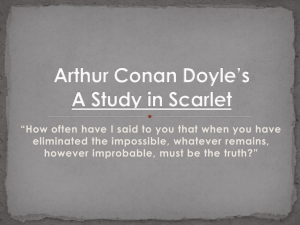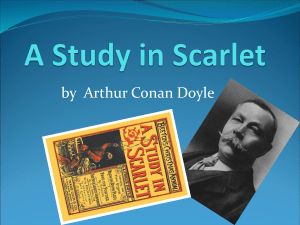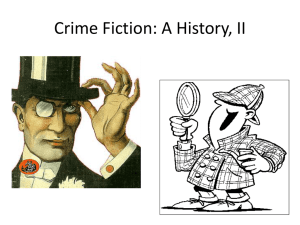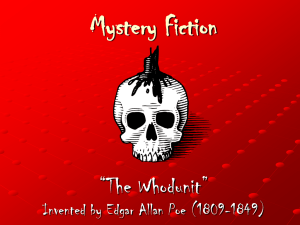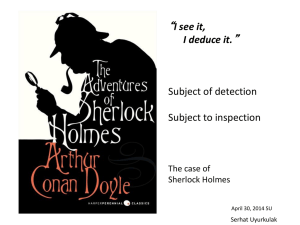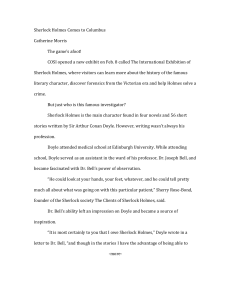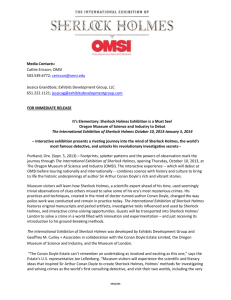visitors mystery
advertisement
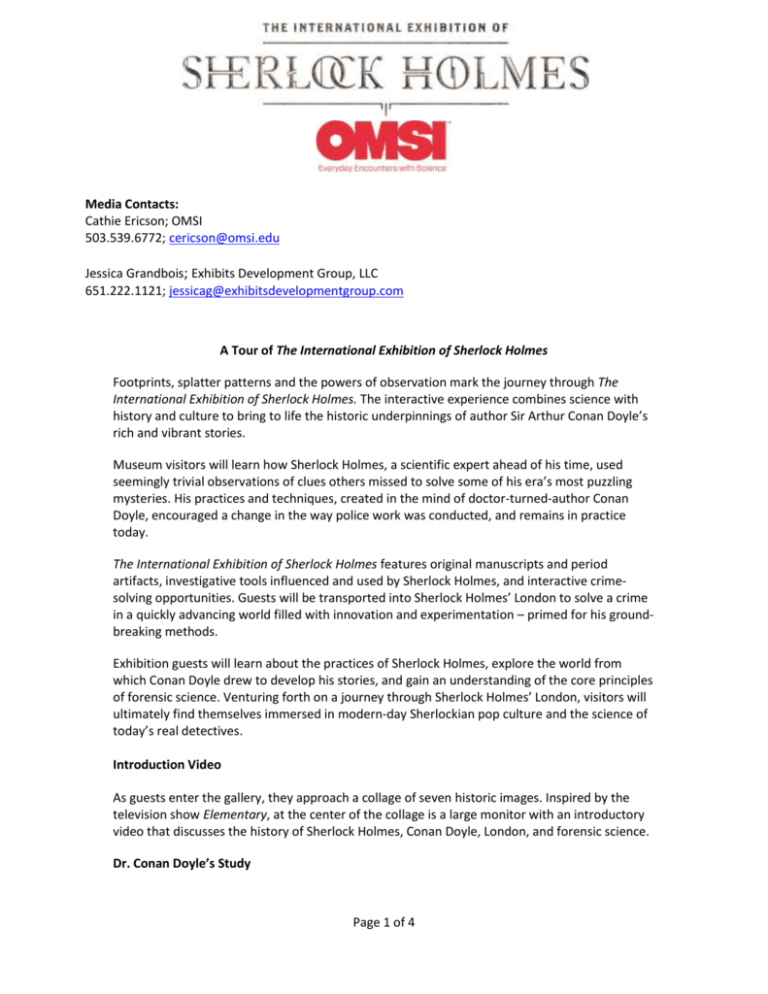
Media Contacts: Cathie Ericson; OMSI 503.539.6772; cericson@omsi.edu Jessica Grandbois; Exhibits Development Group, LLC 651.222.1121; jessicag@exhibitsdevelopmentgroup.com Jessica Grandbois; Exhibits Development Group, LLC 651.222.1121; jessicag@exhibitsdevelopmentgroup.com A Tour of The International Exhibition of Sherlock Holmes Footprints, splatter patterns and the powers of observation mark the journey through The International Exhibition of Sherlock Holmes. The interactive experience combines science with history and culture to bring to life the historic underpinnings of author Sir Arthur Conan Doyle’s rich and vibrant stories. Museum visitors will learn how Sherlock Holmes, a scientific expert ahead of his time, used seemingly trivial observations of clues others missed to solve some of his era’s most puzzling mysteries. His practices and techniques, created in the mind of doctor-turned-author Conan Doyle, encouraged a change in the way police work was conducted, and remains in practice today. The International Exhibition of Sherlock Holmes features original manuscripts and period artifacts, investigative tools influenced and used by Sherlock Holmes, and interactive crimesolving opportunities. Guests will be transported into Sherlock Holmes’ London to solve a crime in a quickly advancing world filled with innovation and experimentation – primed for his groundbreaking methods. Exhibition guests will learn about the practices of Sherlock Holmes, explore the world from which Conan Doyle drew to develop his stories, and gain an understanding of the core principles of forensic science. Venturing forth on a journey through Sherlock Holmes’ London, visitors will ultimately find themselves immersed in modern-day Sherlockian pop culture and the science of today’s real detectives. Introduction Video As guests enter the gallery, they approach a collage of seven historic images. Inspired by the television show Elementary, at the center of the collage is a large monitor with an introductory video that discusses the history of Sherlock Holmes, Conan Doyle, London, and forensic science. Dr. Conan Doyle’s Study Page 1 of 4 Conan Doyle, a scientifically educated physician, was a curious and tireless investigator his entire life. Guests will explore his world and life starting as a medical student at Edinburgh University, then as an apprentice at Royal Surgeons’ Hall, next a practicing physician in Southsea, Portsmouth, in the 1880s, and finally as a creator of literary genius who moved to London in the early 1890s and became a full time author. The centerpiece is Conan Doyle’s desk, surrounded by vignettes of experiences that eventually brought Sherlock Holmes to life. Guests are encouraged to explore academic, professional and cultural influences: the professors who awakened Conan Doyle’s interest in observation and deduction, period-specific medical innovations, the state of Victorian London and its sensationalized crime, and contemporary mystery writers who influenced his writing. On display will be an original manuscript, letters and illustrations that shed light on the experiences that influenced Conan Doyle in creating Sherlock Holmes. Transition Guests then leave Conan Doyle’s study to find themselves surrounded by images of Victorian London. Street urchins, traffic jams, scores of pedestrians, newspaper stands, riverbanks full of commerce, and a growing population add to the bustle of London, circa 1895. All of the images are from the Museum of London’s image archive. Science and History Sherlock Holmes solved mysteries using observation, deduction, and solid scientific experimentation, something real-world detectives (police or private) had not yet embraced. Guests enter the Baker Street Underground Station and find themselves in the middle of a bustling center of innovation in the form of an International Science Exhibition. As guests enter the Science Exhibition, they get their photograph taken in the style of the cutting-edge 1895 photographic technology in front of one of three painted murals. The murals roll down and are typical of fair photo stands in the late-1800s. Guests can don hats and other props to pose as though they are at 221B Baker Street, on a foggy London road, or in the Dartmoor countryside of The Hound of the Baskervilles. An appropriately-dressed photographer will take the photos using contemporary camera equipment disguised to look Victorian. Photograph packages are available for purchase at the end of the exhibition. Guests will participate in experiments of their own by exploring the developments in science and technology in the 1890s – from telecommunications and printing to botany and chemistry – that are still highly relevant today. Page 2 of 4 Supported by forensics expert and crime historian E. J. Wagner, author of The Science of Sherlock Holmes, the exhibition delves into real forensic studies in order to demonstrate the link between the Sherlock Holmes stories, detective science and the world of today. Sherlock Holmes in Baker Street Next up is Sherlock Holmes’ and Dr. Watson’s sitting-room at 221B Baker Street, London, where their investigations began and concluded – a room looming large in popular imagination around the globe ever since the first Sherlock Holmes tale, A Study in Scarlet, in 1887. As guests enter the sitting room, the space feels inhabited, as though Sherlock has just stepped out. The room is dark, lit only by the fire, gaslights and the flickers of a chemistry set’s Bunsen burners. The air is thick and the clutter oppressive and overwhelming, though on closer inspection, the clutter shows the hand of a brilliant eccentric with many objects from his most recent cases still preserved throughout the room. A jackknife stuck in the mantel with a note from Sherlock Holmes states that the guests are late, poorly dressed and observing the unimportant. Guests are instructed to play a recording made by Sherlock, which provides details about a recent crime. Guests learn that they are needed to help solve a time-sensitive and mysterious event! Become a Detective The new Sherlock Holmes mystery, written exclusively for the exhibition by Sherlockian and acclaimed writer and award-winning Conan Doyle biographer Daniel Stashower, takes the guests on an adventure through the streets of London as they perform scientific experiments, observe details, chase clues and solve a crime. As Holmes’ Baker Street Irregulars, in hopes of becoming detectives-in-training, guests use what they learned in the Underground Station Science Exhibition and Conan Doyle’s Study to solve the mystery. Each mystery location also provides additional information and clues. Scotland Yard’s Inspector Lestrade sees the case differently from Sherlock; if the truth is not revealed in a timely manner, an innocent person may be charged with a terrible crime. Guests must work diligently to make sure this does not happen. Detective notebook in hand, guests document the mystery by way of embossing, stamping, rubbing, punching and drawing. The experience guides them through a crime scene and five themed vignettes. Each vignette includes scientific interactives that let the guests try their hands as professional detectives, using and reinforcing each of the five science principles presented earlier. Culture of Sherlock Page 3 of 4 Returning to the 21st century, guests enter a contemporary gallery. Pop culture enthusiasts will enjoy a robust collection of all things “Sherlockian,” ranging from vintage Sherlock Holmesthemed card games, comics, and magazines, to radio scripts, and movie and television show props and costumes. Featured are props from the Warner Bros.’ current Sherlock Holmes movies set in the Victorian era, alongside costumes, props and behind-the-scenes tools from the hit CBS television show Elementary and the BBC’s Sherlock, both of which set Sherlock Holmes in the present day. The exhibition will offer museum guests the most comprehensive display anywhere of Sherlock Holmes as portrayed in popular imagination over the last 126 years since his creation. Videos Videos in the final gallery will discuss Sherlock Holmes’ and Conan Doyle’s influence on pop culture, history, and forensic science. Six of the country’s leading forensic specialists, many from the Minnesota Bureau of Criminal Apprehension, tell us how they solve mysteries today using many of the very same techniques that Sherlock Holmes used more than a century earlier. The actual tools and some evidence is shown, presenting an accurate example of the importance and complicity of real forensic science. See the actual tools they use in an accompanying display. Retail Store Each guest will receive a detective’s notebook, an interactive element used throughout most of the exhibition that becomes a take-home souvenir. Guests may wish to augment the notebook with other gear, so the final stop will be the Sherlock Retail Store, which features all the latest detective gadgets, books, and Sherlockian ware. The International Exhibition of Sherlock Holmes was developed by Exhibits Development Group and Geoffrey M. Curley + Associates in collaboration with the Conan Doyle Estate Limited, the Oregon Museum of Science and Industry, and the Museum of London. ### Page 4 of 4

